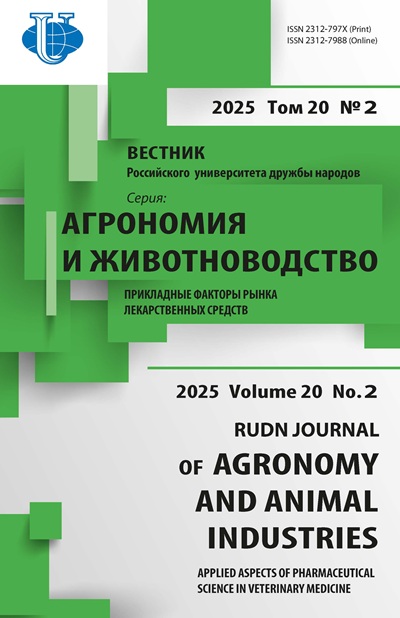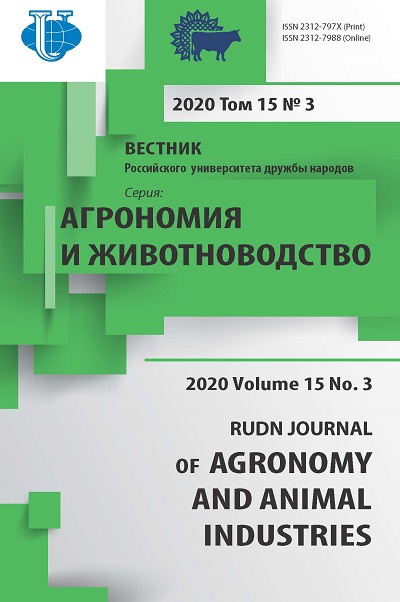Antioxidant contents in potato cultivars from the collection of Russian Potato Research Center
- Authors: Gins E.M.1,2, Moskalev E.A.1,2, Polivanova O.B.1,3, Mityushkin A.V.1, Simakov E.A.1
-
Affiliations:
- Russian Potato Research Center
- Peoples’ Friendship University of Russia (RUDN University)
- Russian State Agrarian University - Moscow Timiryazev Agricultural Academy
- Issue: Vol 15, No 3 (2020)
- Pages: 242-252
- Section: Morphology and biochemistry of plants
- URL: https://agrojournal.rudn.ru/agronomy/article/view/19583
- DOI: https://doi.org/10.22363/2312-797X-2020-15-3-242-252
- ID: 19583
Cite item
Full Text
Abstract
Antioxidants protect not only plants, but also humans from oxidative stress. Plant antioxidants include phenolic compounds: phenolic acids, flavonoids, anthocyanins, and vitamin C. Potatoes are one of the most consumed crops in the world and can serve as a promising source of antioxidants in the human diet. The aim of the study was to compare secondary low-molecular-weight antioxidants (ascorbic acid, phenolic compounds, flavonoids, total antioxidant content) in 15 cultivars of potatoes with pigmented and white pulp ( Solanum tuberosum L.) to identify genotypes having increased antioxidant activity. The research was conducted in 2019, a week after harvesting. Plants were grown on sod-podzolic soils in the fields of Federal Scientific Vegetable Center. Analysis of the total content of soluble phenolic compounds showed that almost all the studied varieties contained significantly more phenolic compounds in the skin than in the pulp. The maximum level of phenolic compounds was found in Monarkh (purple pulp) and Vympel (light yellow pulp) - 69.33 mg/100 g and 67.93 mg/100 g of fresh mass, respectively. The highest amount of flavonoids was observed in Zhukovsky ranniy (white pulp) and Tayfun (white pulp) - 12.49 mg/100 g and 11.06 mg/100 g of fresh mass, respectively. The highest content of ascorbic acid was determined in Gala (dark yellow pulp) - 15.84, Golubizna (white pulp) and Red Scarlett (yellow pulp) - 14.08 mg%. The maximum total content of hydrophobic antioxidants was found in Zhukovsky ranniy (white pulp) - 0.38 mg. eq. HA/g and Red Scarlett (yellow pulp) - 0.37 mg. eq. HA/g.
About the authors
Ekaterina Muratovna Gins
Russian Potato Research Center; Peoples’ Friendship University of Russia (RUDN University)
Author for correspondence.
Email: katya.888888@yandex.ru
PhD student, Peoples’ Friendship University of Russia; Junior Researcher, Russian Potato Research Center
23 Lorkha st., Kraskovo vil., Lyubertsy district, Moscow region, 140051, Russian Federation; 8 Miklukho-Maklaya st., Moscow, 117198, Russian FederationEvgeny Aleksandrovich Moskalev
Russian Potato Research Center; Peoples’ Friendship University of Russia (RUDN University)
Email: kmlgwork@mail.ru
PhD student, Peoples’ Friendship University of Russia; Junior Researcher, Russian Potato Research Center
23 Lorkha st., Kraskovo vil., Lyubertsy district, Moscow region, 140051, Russian Federation; 8 Miklukho-Maklaya st., Moscow, 117198, Russian FederationOksana Borisovna Polivanova
Russian Potato Research Center; Russian State Agrarian University - Moscow Timiryazev Agricultural Academy
Email: polivanovaoks@gmail.com
Candidate of Biological Sciences, Research Associate
23 Lorkha st., Kraskovo vil., Lyubertsy district, Moscow region, 140051, Russian Federation; 49 Timiryazevskaya st., Moscow, 127550, Russian FederationAleksey Vladimirovich Mityushkin
Russian Potato Research Center
Email: zakazvniikh@mail.ru
Candidate of Agricultural Sciences, Leading Researcher, Head of the Laboratory for Breeding Varieties for Processing
23 Lorkha st., Kraskovo vil., Lyubertsy district, Moscow region, 140051, Russian FederationEvgeny Alekseevich Simakov
Russian Potato Research Center
Email: vniikh@mail.ru
Doctor of Agricultural Sciences, Chief Researcher, Head of the Department of Experimental Potato Gene Pool
23 Lorkha st., Kraskovo vil., Lyubertsy district, Moscow region, 140051, Russian FederationReferences
- FAOSTAT. Crop production. Available from: http://www.fao.org/faostat/en/ [Accessed 18th April 2020].
- Andre CM, Ghislain M, Bertin P, Oufir M, del Rosario Herrera M, Hoffmann L, et al. Andean Potato Cultivars (Solanum tuberosum L.) as a source of antioxidant and mineral micronutrients. Journal of Agricultural and Food Chemistry. 2007; 55(2):366-378. doi: 10.1021/jf062740i
- Fan G, Han Y, Gu Z, Gu F. Composition and colour stability of anthocyanins extracted from fermented purple sweet potato culture. LWT - Food Science and Technology. 2008; 41(8):1412-1416. doi: 10.1016/j. lwt.2007.09.003
- Kita A, Bąkowska-Barczak A, Hamouz K, Kułakowska K, Lisińska G. The effect of frying on anthocyanin stability and antioxidant activity of crisps from red- and purple-fleshed potatoes (Solanum tuberosum L.) Journal of Food Composition and Analysis. 2013; 32(2):169-175. doi: 10.1016/j.jfca.2013.09.006
- Young IS, Woodside JV. Antioxidants in health and disease. J Clin Pathol. 2001; 54(3):176-186.
- Skrovankova S, Sumczynski D, Mlcek J, Jurikova T, Sochor J. Bioactive compounds and antioxidant activity in different types of berries. Int J Mol Sci. 2015; 16(10):24673-24706. doi: 10.3390/ijms161024673
- Hercberg S, Galan P, Preziosi P, Alfarez MJ, Vazquez C. The potential role of antioxidant vitamins in preventing cardiovascular diseases and cancers. Nutrition. 1998; 14(6):513-520. doi: 10.1016/S0899- 9007(98)00040-9
- Al-Saikhan MS, Howard LR, Miller JC. Antioxidant activity and total phenolics in different genotypes of potato (Solanum tuberosum L.). Journal of Food Science. 1995; 60(2):341-343. doi: 10.1111/j.1365-2621.1995. tb05668.x
- Hacişevkı A. An overview of ascorbic acid biochemistry. J Fac Pharm Ankara. 2009; 38(3):233-255.
- Koyuncu MA, Dilmacunal T. Determination of vitamin C and organic acid changes in strawberry by HPLC during cold storage. Not Bot Horti Agrobot Cluj. 2010;38(3):95-98. doi: 10.15835/nbha3834819
- Lachman J, Hamouz K. Red and purple coloured potatoes as a significant antioxidant source in human nutrition - a review. Plant Soil Environ. 2005; 51(11):477-482.
- Lewis CE, Walkel JR, Lancaster JE, Sutton KH. Determination of anthocyanins, flavonoids and phenolic acids in potatoes. I: Coloured cultivars of Solanum tuberosum L. J Sci Food Agric. 1998;77(1): 45-57. doi: 10.1002/(SICI)1097-0010(199805)77:1<45:: AID-JSFA1>3.0.CO;2-S
- Goyer A, Picard M, Hellmann HA, Mooney SL. Effect of low temperature storage on the content of folate, vitamin B6, ascorbic acid, chlorogenic acid, tyrosine, and phenylalanine in potatoes. Journal of the Science of Food and Agriculture. 2019; 99(10):4842-4848. doi: 10.1002/jsfa.9750
- Hajšlová J, Schulzová V, Slanina P, Janné K, Hellenäs KE, Andersson CH. Quality of organically and conventionally grown potatoes: Four-year study of micronutrients, metals, secondary metabolites, enzymic browning and organoleptic properties. Food Addit Contam. 2005; 22(6):514-534. doi: 10.1080/02652030500137827
- Burg P, Fraile P. Vitamin C destruction during the cooking of a potato dish. LWT-Food Science and Technology. 1995; 28(5):506-514. doi: 10.1006/fstl.1995.0085
- Burgos G, Auqui S, Amoros W, Salas E, Bonierbale M. Ascorbic acid concentration of native Andean potato varieties as affected by environment, cooking and storage. J Food Comp Anal. 2009; 22(6):533-538. doi: 10.1016/j.jfca.2008.05.013
- Rytel E, Lisińska G. Changes in the content of vitamin C in potato tubers during the cooking and processing to fried and dried products. Zywn Nauk Technol Ja. 2007; 6(55): 186-197.
- Grudzińska M, Czerko Z, Zarzyńska K, Borowska-Komenda M. Bioactive Compounds in Potato Tubers: Effects of Farming System, Cooking Method, and Flesh Color. PLoS ONE. 2016; 11(5): e0153980. doi: 10.1371/ journal.pone.0153980
- Ainsworth EA, Gillespie KM. Estimation of total phenolic content and other oxidation substrates in plant tissues using Folin-Ciocalteu reagent. Nature Protocols. 2007; 2(4):875-877. doi: 10.1038/nprot.2007.102
- Garg D, Shaikh A, Marar T. In-vitro antioxidant activity and phytochemical analysis in extracts of Hibiscus rosa-sinensis stem and leaves. Free Radical Antioxidants. 2012; 2(3):41-46. doi: 10.5530/ax.2012.3.6
- Sapozhnikova EV, Dorofeeva LS. Determination of content of ascorbic acid in colored plant extracts using iodometric method. Food industry. 1966; (5): 29-31. (In Russ.)
- Gins MS, Gins VK, Baikov AA, Rabinovich AM, Kononkov PF, Solntsev MK. Antioxidant content in medicinal plants and vegetables with therapeutic potential for treating cancer. Problems of Biological, Medical and Pharmaceutical Chemistry. 2013; 11(2):10-15. (In Russ.)
- Gins MS, Gins VK, Baikov AA, Romanova EV, Kononkov PF, Torres MK, Lapo OA. Metodika analiza summarnogo soderzhaniya antioksidantov v listovykh i li-stostebel’nykh ovoshchnykh kul’turakh [Method for analysis of total content of antioxidants in leaf and leafy vegetable crops]. Moscow: PFUR Publ.; 2013. (In Russ.)
- Visvanathan R, Jayathilake C, Chaminda Jayawardana B, Liyanage R. Health-beneficial properties of potato and compounds of interest. Journal of the Science of Food and Agriculture. 2016; 96(15):4850-4860. doi: 10.1002/jsfa.7848
- Lachman J, Hamouz K, Orsak M, Pivec V, Dvorak P. The influence of flesh colour and growing locality on polyphenolic content and antioxidant activity in potatoes. Sci Hort. 2008;117(2):109-114. doi: 10.1016/j. scienta.2008.03.030
Supplementary files















